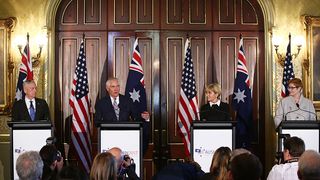This week's AUSMIN was in stark contrast to the last which took place under the Obama administration in 2015. The remarkably short length of this year’s joint statement alone makes obvious the difference between an experienced Obama administration near the end of two terms of governing – and comfortably engaged in a wide range of regional and bilateral matters – and a Trump administration that is, as Senator John McCain told an Australian audience last week, still “finding its feet”.
What is particularly peculiar about this year’s statement, however, is the absence of any significant mention of the critical economic relationship between the United States and Australia. While the meetings are between the respective heads of each country’s defence departments and chief diplomats, and not the chief trade or treasury officials, it’s nonetheless noteworthy that only after being asked by a member of the media did US Secretary Tillerson make mention of the economic relationship, most notably the hundreds of thousands of jobs that are direct results of it.
President Trump has made it abundantly clear that trade and jobs will be hallmarks of his administration, and few bilateral stories could be more positive than the US-Australian economic relationship. The United States is the largest foreign investor in Australia, the largest destination of Australian foreign investment, and Australia’s second largest trading partner. Both the US State Department and the Australian foreign minister regularly highlight the strength of the US-Australian economic relationship. All of this would lead one to think that the US-Australian economic relationship would be a prominent theme of the AUSMIN joint statement.
The most likely reason that the economic relationship went unmentioned in the joint statement is that there are simply fewer areas for the US-Australian economic relationship to grow from a government standpoint. The United States and Australia already have a bilateral free trade deal, among many other bilateral treaties and arrangements that make up the economic relationship. When President Trump unilaterally abandoned the Trans Pacific Partnership (TPP), he also abandoned the last joint economic effort that the United States and Australia worked together on. For years, the TPP was an immense, shared undertaking that earned significant focus in AUSMIN meetings, but now that it is no longer a mutually desired outcome, the governments have yet to find a suitable alternative economic agenda.
While future AUSMIN meetings may include more substantial references to the major economic ties between the United States and Australia, ultimately, less focus will be merited as long as there are fewer joint efforts to make together.






